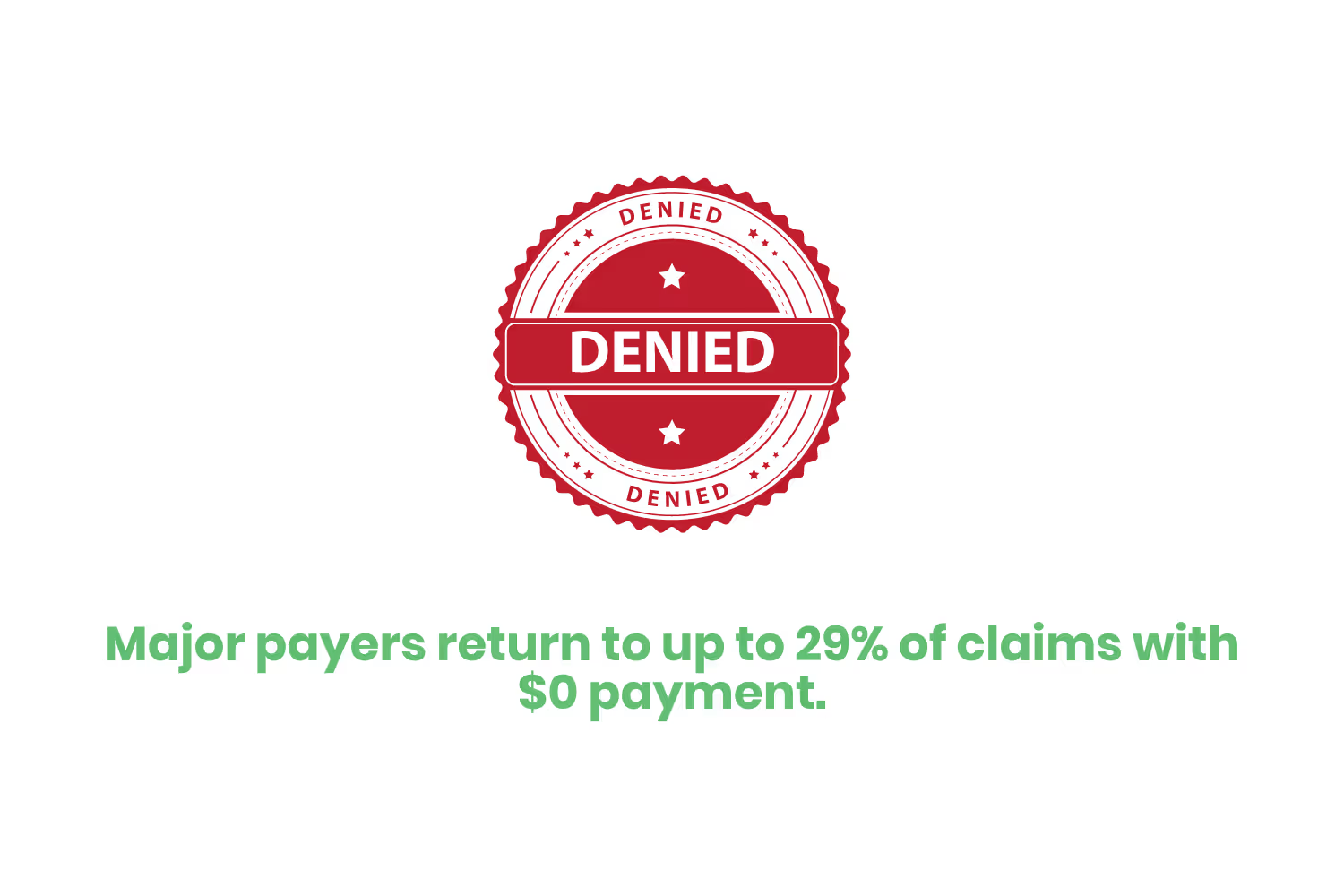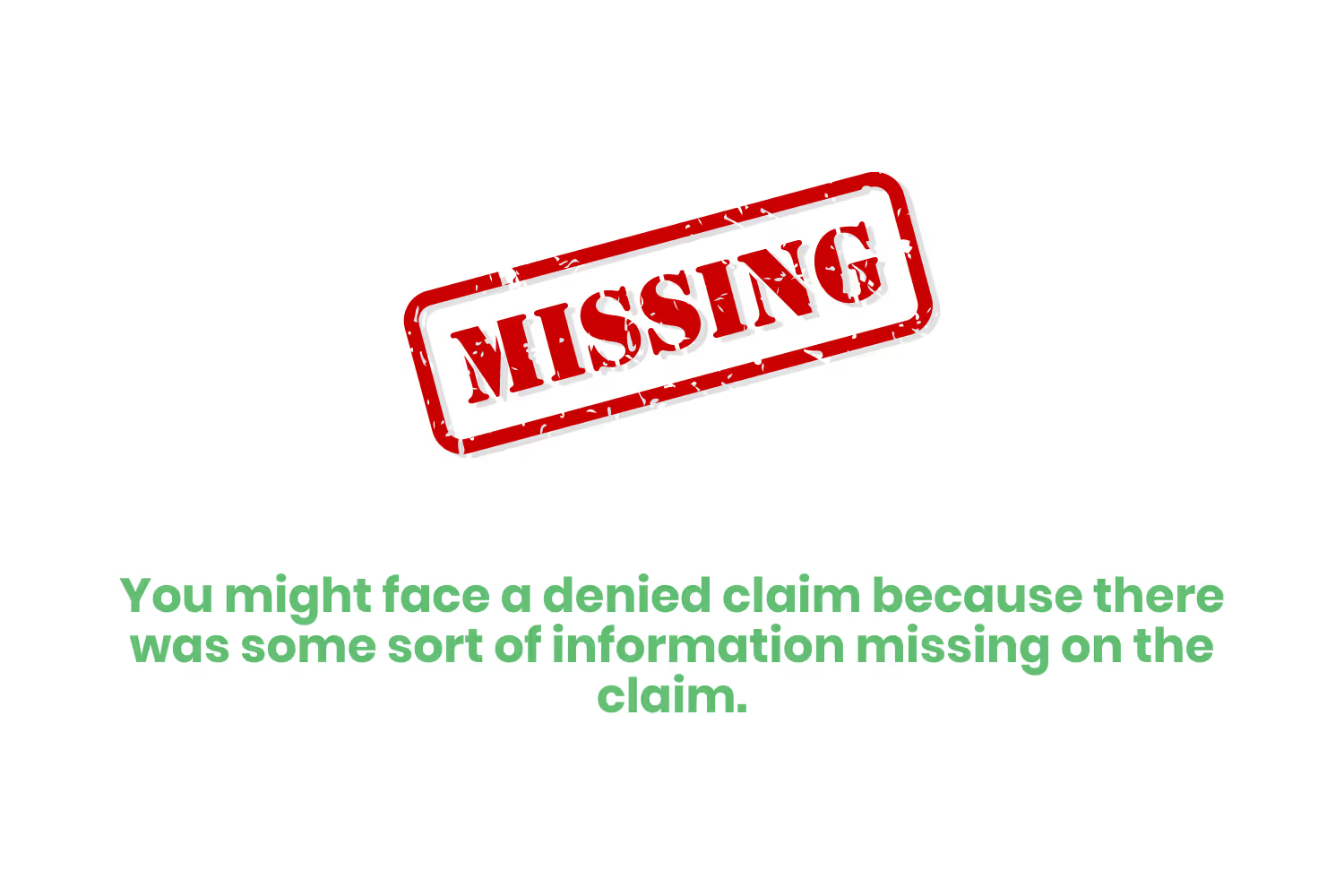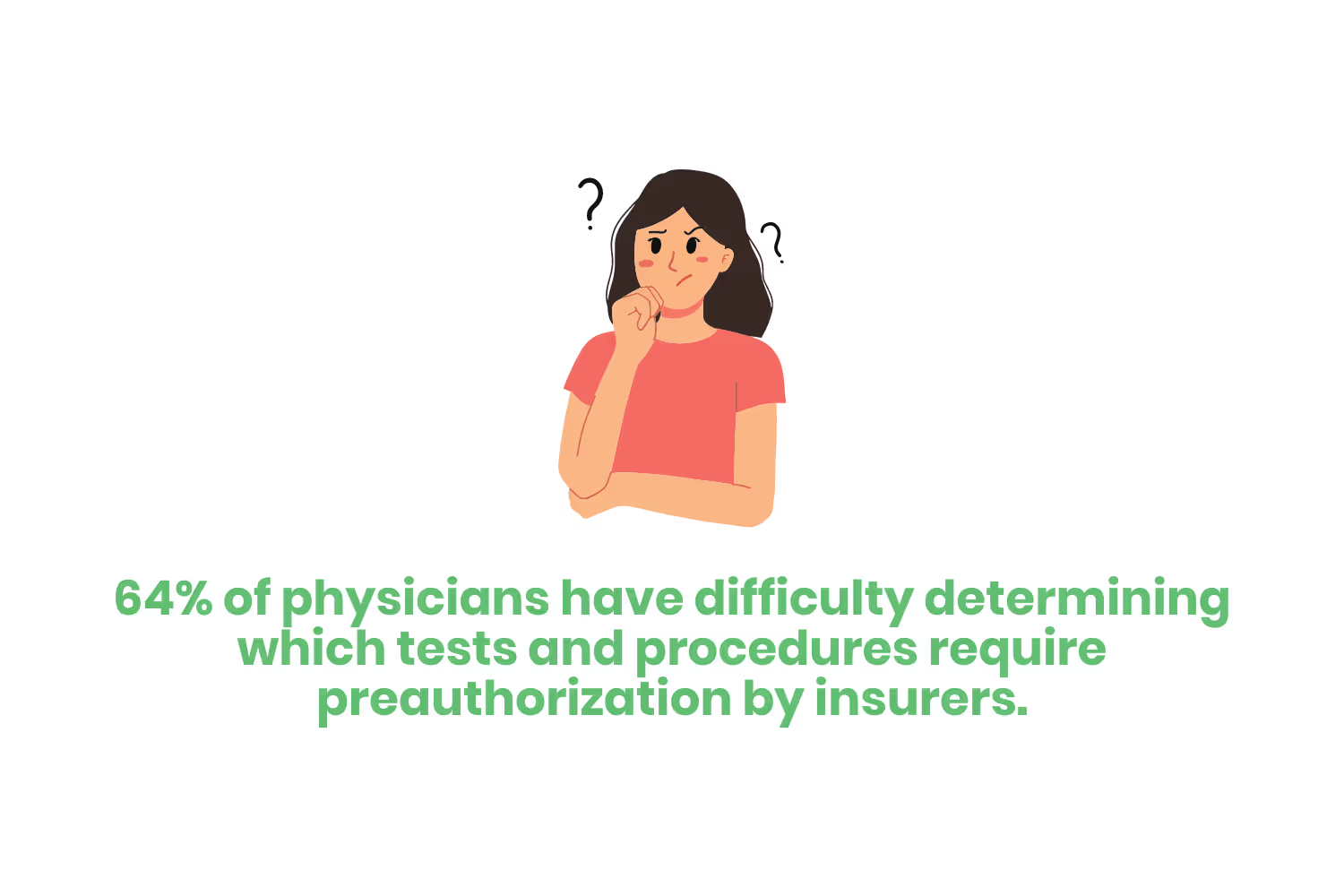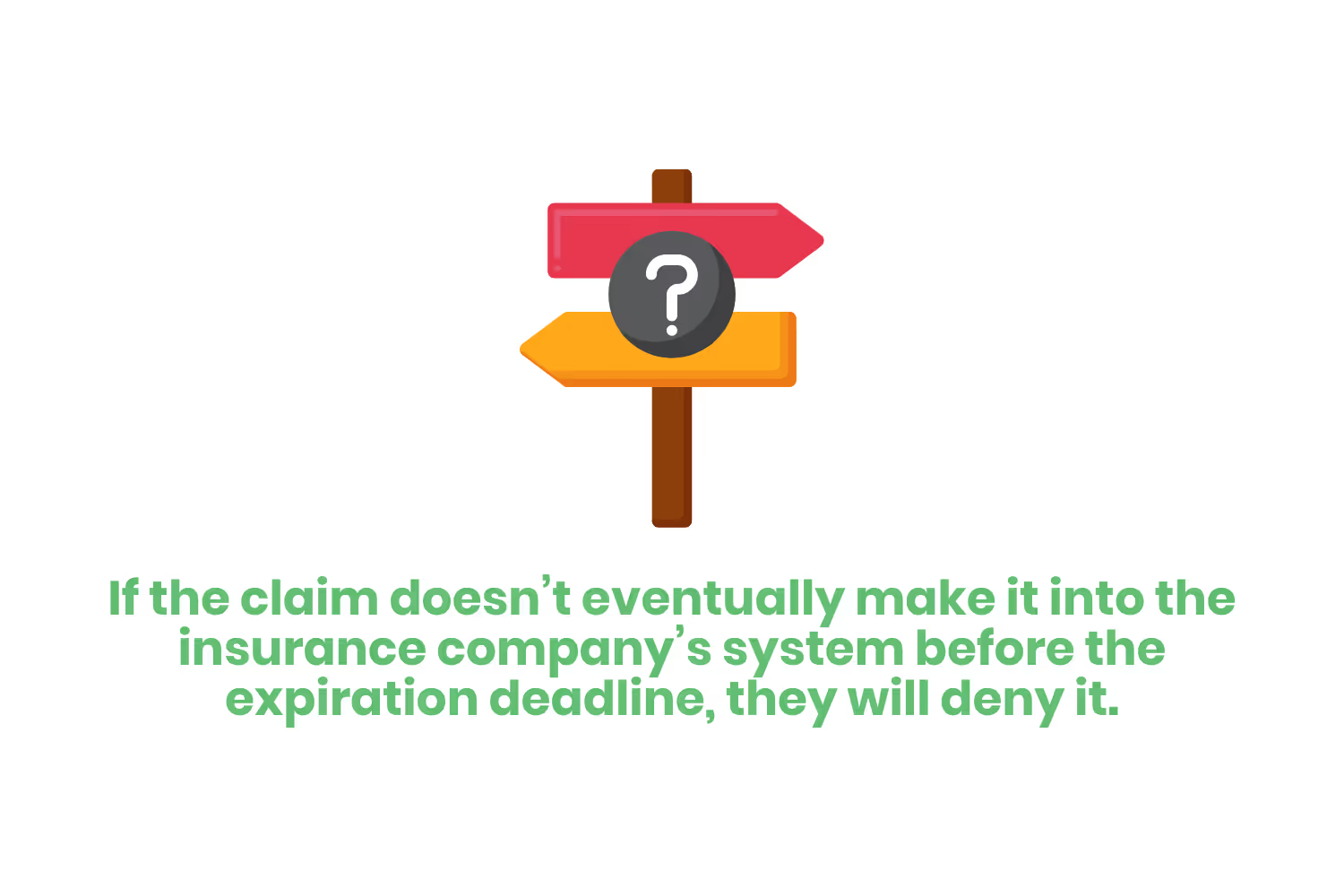14 Illuminating Claim Denial Reasons & Their Codes
Poor management of the claims process can cost your practice thousands. But what kinds of things can go wrong? Here are 14 claim denial reasons and what you can do about them.

Getting paid as a doctor should be straightforward, right? Provide a service, submit a claim, and receive payment.
It sounds simple enough, but a lot could go wrong with the process. Maybe there was some sort of coding or data entry error. Maybe there was a coding edit made by an insurance company.
The scheduler must collect accurate patient demographic information and insurance numbers. Registration must verify the patient’s information. Nurses need to accurately enter all of the information into their computers during the visit. Clinical or support staff need to note potentially non-covered services and obtain beneficiary notices from Medicare patients in advance.
Physicians need to ensure their documentation reflects the services performed while seeing the patient.

Sounds super complicated, doesn’t it?
The American Medical Association’s most recent study found that major payers return to up to 29% of claims with $0 payment. This happens most commonly because the patient is responsible for the balance. It also happens 7% of the time because of claim edits and 5% of the time because of other denials.
The good news is that many denied claims can get reworked and resubmitted. However, this is costly for your practice. A study by the Medical Group Management Association found that it costs about $25 a claim to rework the claim. That's why more than 50% of denied claims are never reworked.
Poor management of the claims process can cost your practice thousands. It’s detrimental to the financial health and sustainability of the practice. This is why you should avoid claim denials and it should be the responsibility of everyone in the practice.
But what kinds of things can go wrong? Here are 14 claim denial reasons and what you can do about them.
Incomplete/Incorrect Coding
Each diagnosis must follow the ICD-10-CM standard. In a nutshell, a doctor’s diagnosis becomes a code of letters and numbers for insurance companies to understand what happened in the exam room.
The code must have the maximum number of digits to use it. Otherwise, there will be some sort of error.
An insurance company may deny a claim because of a coding error. Maybe it was incorrect, incomplete, or inadequate.
If you receive a denial within this reason category, in most cases the payer will send it back to you with code CO 11.
Luckily for you, this is an easy fix! Just resubmit the claim with the correct coding information.
Missing Information
You might face a denied claim because there was some sort of information missing on the claim. Maybe you mistyped the patient’s last name or you forgot to enter their address.
Most of the time, this kind of denial happens because you are missing the date of the accident, medical emergency, or onset.
This denial reason also usually follows a CO 11 code from the payer.

Inaccurate Patient Information
Maybe you filled out all of the different sections of the medical claim you just submitted. Therefore, there’s zero missing information. All good to go right?
Wrong.
If you misspelled the patient’s name, mistyped their date of birth, or clicked on the wrong gender, your claim will get denied.
Some things you should double-check prior to claim submission to catch this error like…
- Policy number
- Needing a group number
- Any exclusions
- Proper diagnosis code
- Typos in patient information
The standard denial code that comes alongside inaccurate patient information is CO 16.
Timely Filing
Let’s say there are absolutely no errors or typos in the claim. But you missed the time window to submit it set by the payer. Now you have another denial!
If you want to get technical, experts called this denial reason a “timely filing limit denial”.
Most insurance companies have a deadline when it comes to filing a claim. For example, you may have 90 days to file a claim from the time you provided the services. However, some insurance companies only allow a time frame of 30 days.
When you file a claim past the insurance deadline, the insurance company will reject the claim
Make sure you know how long you have to file a claim. Also, make sure you know how long you have to appeal the decision if you face a denied claim.
Denied claims due to timely filing issues come back from payers as CO 29.

Inaccurate Insurance ID
It’s your responsibility to verify a patient’s current information at each visit. This includes changes to insurance!
Old insurance cards and ID numbers submitted on a new claim may not get recognized by an insurance company. Make sure to take the time to double-check that you have current information and you don’t have any typos in the insurance ID.
This one comes back as CO 15.
Lack of Proper Authorization
Many insurance companies require the patient to obtain pre-authorization for services before treatment. But 64% of physicians have difficulty determining which tests and procedures require preauthorization by insurers.
This is especially true for non-routine services, like…
- Hospitalizations
- Surgeries
- Behavioral care
If you provide services without the proper authorization, the insurance company will likely deny the claim.
Luckily for you, this problem is preventable. You can obtain pre-authorization from the insurance company on behalf of the patient.
This denial reason usually comes back as CO 197.

Non-Covered Services
Some health insurance companies have a list of services they don’t cover.
For example, some services that often go uncovered are…
- Cosmetic surgery
- Infertility treatment
- Gastric bypass
Some plans may also have limitations about how much of a service they cover. For example, an insurance company may cover only 30 days of inpatient treatment for condition XYZ.
When you submit a claim for benefits that aren’t covered by the insurance company, they will deny the claim. The same is true for a claim about a treatment that exceeded a limitation.
You’ll come across this type of denial reason most often with Medicare claims. As such, they’ll show up as CO 50.
Lack of Medical Necessity
For many routine services, necessity is largely assumed. However, insurance companies will expect some form of demonstration of the medical need for treatment by a specialist. The same is true for many office procedures and surgeries.
Most health plans and insurance companies evaluate medical necessity on their own list of criteria. If they deem the claim unnecessary, they will deny the claim unless you can prove otherwise.
Medical necessity gets categorized frequently as CO 50 as well.

Pre-Existing Condition
Some insurance plans have a pre-existing condition exclusion clause. If the insurance company discovers a submitted claim about the treatment of a condition that existed before the Affordable Care Act mandate, they will reject the claim.
Insurance companies might deny a claim for a separate, new illness if any other kind of pre-existing condition was not disclosed initially. If this happens, it is usually because the insurance company wouldn’t have offered coverage in the first place if the patient had disclosed the pre-existing condition beforehand.
CO 51 is the denial code you’ll oftentimes see for pre-existing condition-related denials.
Lack of Progress
This reason for a claim denial may seem a bit strange, but hear me out. If a patient’s condition requires long-term care, then an insurance company will expect to see positive results. They want to see improvement in the money they give the doctor’s office.
If the patient receives long-term care with little improvement in their condition, many insurance companies will deny their continued coverage. This results in a denied claim.
Sometimes you can overturn this decision on appeal.
Insurance Lost The Claim
Every once in a while, the insurance company will lose the claim. In the process, the window to process the claim will expire.
If the claim doesn’t eventually make it into the insurance company’s system before the expiration deadline, they will deny it.
This is one of the most frustrating reasons for dealing with denied claims. After all, you submitted the claim on time and you faced a denial even though you did nothing wrong.
As a doctor, you are responsible for your patient’s medical records. Even if the claim denial happened because of an error on the insurance provider’s end, you have to make sure the claim goes through and gets processed on time.
This denial reason comes back as a CO 16, which makes it tricky. To pinpoint this denial reason, you’ll have to track your claim submission and see if you ever delivered it to the payer.

Bundled Services
Sometimes you should not report a service separately from another because the work was already captured as part of another service in a separate claim.
For example, taking someone's pulse has its own CPT code, but when it is part of someone’s general evaluation in the doctor’s office, an insurance company will not pay for the pulse part separately. The denial would say that taking someone’s pulse is part of another service on the claim, which in this case, is the general intake for the office visit.
Each quarter, Medicare publishes files of parts of codes that should not go into the same bill together because they are mutually exclusive or one is more comprehensive than the other. Billing staff needs to understand that certain codes should not appear on a claim together or else they will face a denial.
Make sure you don’t have codes that overlap with the service you provide. Otherwise, an insurance provider will think you are overbilling and will deny your claim.
Improper Modifer Use
Two of the most common modifiers are 25 and 59.
Modifier 25 represents a significant, separately identifiable evaluation and management (E/M) service provided on the same day as another procedure or service. You can only attach this modifier to codes found within the E/M section of the CPT book.
Modifier 59 indicates that a procedure or service is distinct from another procedure or service because of…
- Happened during a separate encounter
- Was performed on a separate organ/structure
- Was performed by a different provider
- Does not overlap with the usual components of the main service
When you use a modifier incorrectly, an insurance provider will deny the service. You can prevent these denials by making sure you educate the coding and billing staff on the appropriate and inappropriate use of common modifiers.
Many practice management systems can help reduce these denials. They help practices establish error alerts when you use a code incorrectly.
This reason usually comes through as RARC N519.

Inconsistent Data
Data inconsistency is a real problem when it comes to claim denials.
Common examples include…
- Using a diagnosis for a female condition on a claim about a male patient
- Using a flu vaccine billed with a diagnosis of pneumococcal vaccine
- Using a provider code for infants but the patient is an adult
These kinds of problems are the result of transposed numbers or accidental data entry errors. To prevent them, you should set up alerts to warn you when a discrepancy happens.
This denial reason is usually identified under the RARC code N56.
Conclusion
A practice should put every effort into reducing denials. The first place to start is understanding why denials happen.
To identify the sources of your denials, you should run a report that displays denial reasons, procedure codes reported, modifiers, diagnosis codes, and payers. You can then sort the report by each of the reasons listed in this blog post to determine how your practice can improve itself and stop denials from happening.
For every 15 denials a practice prevents each month, doctors will receive a reimbursement sooner and save about $4,500 per year on costs associated with correcting the claims. Sounds like a sweet deal right? Save time, effort, and money!
At the end of the day, nobody likes having to rework denied claims. It increases the time it takes for you to get paid. Fortunately, there is a little something called EDI that can help you clean claims, make sure there aren’t any errors, and get them submitted to the payer on time.
If you would like to implement EDI to avoid denials, contact Etactics or click here.
Emphasize your product's unique features or benefits to differentiate it from competitors
In nec dictum adipiscing pharetra enim etiam scelerisque dolor purus ipsum egestas cursus vulputate arcu egestas ut eu sed mollis consectetur mattis pharetra curabitur et maecenas in mattis fames consectetur ipsum quis risus mauris aliquam ornare nisl purus at ipsum nulla accumsan consectetur vestibulum suspendisse aliquam condimentum scelerisque lacinia pellentesque vestibulum condimentum turpis ligula pharetra dictum sapien facilisis sapien at sagittis et cursus congue.
- Pharetra curabitur et maecenas in mattis fames consectetur ipsum quis risus.
- Justo urna nisi auctor consequat consectetur dolor lectus blandit.
- Eget egestas volutpat lacinia vestibulum vitae mattis hendrerit.
- Ornare elit odio tellus orci bibendum dictum id sem congue enim amet diam.
Incorporate statistics or specific numbers to highlight the effectiveness or popularity of your offering
Convallis pellentesque ullamcorper sapien sed tristique fermentum proin amet quam tincidunt feugiat vitae neque quisque odio ut pellentesque ac mauris eget lectus. Pretium arcu turpis lacus sapien sit at eu sapien duis magna nunc nibh nam non ut nibh ultrices ultrices elementum egestas enim nisl sed cursus pellentesque sit dignissim enim euismod sit et convallis sed pelis viverra quam at nisl sit pharetra enim nisl nec vestibulum posuere in volutpat sed blandit neque risus.

Use time-sensitive language to encourage immediate action, such as "Limited Time Offer
Feugiat vitae neque quisque odio ut pellentesque ac mauris eget lectus. Pretium arcu turpis lacus sapien sit at eu sapien duis magna nunc nibh nam non ut nibh ultrices ultrices elementum egestas enim nisl sed cursus pellentesque sit dignissim enim euismod sit et convallis sed pelis viverra quam at nisl sit pharetra enim nisl nec vestibulum posuere in volutpat sed blandit neque risus.
- Pharetra curabitur et maecenas in mattis fames consectetur ipsum quis risus.
- Justo urna nisi auctor consequat consectetur dolor lectus blandit.
- Eget egestas volutpat lacinia vestibulum vitae mattis hendrerit.
- Ornare elit odio tellus orci bibendum dictum id sem congue enim amet diam.
Address customer pain points directly by showing how your product solves their problems
Feugiat vitae neque quisque odio ut pellentesque ac mauris eget lectus. Pretium arcu turpis lacus sapien sit at eu sapien duis magna nunc nibh nam non ut nibh ultrices ultrices elementum egestas enim nisl sed cursus pellentesque sit dignissim enim euismod sit et convallis sed pelis viverra quam at nisl sit pharetra enim nisl nec vestibulum posuere in volutpat sed blandit neque risus.
Vel etiam vel amet aenean eget in habitasse nunc duis tellus sem turpis risus aliquam ac volutpat tellus eu faucibus ullamcorper.
Tailor titles to your ideal customer segment using phrases like "Designed for Busy Professionals
Sed pretium id nibh id sit felis vitae volutpat volutpat adipiscing at sodales neque lectus mi phasellus commodo at elit suspendisse ornare faucibus lectus purus viverra in nec aliquet commodo et sed sed nisi tempor mi pellentesque arcu viverra pretium duis enim vulputate dignissim etiam ultrices vitae neque urna proin nibh diam turpis augue lacus.



![[ANSWERED] What is a Long-Term Care (LTC) Pharmacy](https://cdn.prod.website-files.com/67e2b8210878abcba6f91ae6/68d687806a075a1cf64659b0_WhatisLongTermCarePharmacy_925.avif)
